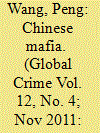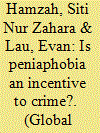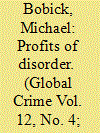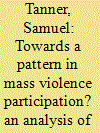|
|
|
Sort Order |
|
|
|
Items / Page
|
|
|
|
|
|
|
| Srl | Item |
| 1 |
ID:
107044


|
|
|
|
|
| Publication |
2011.
|
| Summary/Abstract |
Gambetta's theoretical framework focuses on two important aspects directly relating to the birth and development of mafias, namely a demand for private protection and a supply of the same. In the Post-Mao era, China started its transition from a centrally controlled economy to a market-directed economy by adopting reform and opening-up policies. The widespread creation of property rights has exponentially enlarged the demand for protection. However, property rights are ambiguously defined in the Chinese legal system, and the state is unable and unwilling to provide efficient and sufficient law enforcement mechanisms for needy people because of the rampant corruption of government officials and the weak judicial system. In this case, the mafia that is interested in the private provision of protection developed into an alternative enforcement mechanism for 'securing' property rights in China's economic transition. The most important service offered by the mafia in China is not only to assist business enterprises in monopolising the market, but also to assist local government in China's economic reform.
|
|
|
|
|
|
|
|
|
|
|
|
|
|
|
|
| 2 |
ID:
107045


|
|
|
|
|
| Publication |
2011.
|
| Summary/Abstract |
This article analysed the relationship between crime categories and unemployment rates using a set of panel data for 14 states in Malaysia with data spanning from 1982 to 2008. It is well documented that crime and unemployment are negatively related in Malaysia; the same is the case for both violent and property crime. Increases in unemployment rates cause the consumption expenditure to decrease, especially among households, hence, causing potential earnings from illegitimate activities to drop and discouraging a person from committing a crime. However, the significant properties of the t-statistics indicate that it is important to consider the labour market conditions in employing appropriate policies in fighting crime. That being said, unemployment can indirectly explain hunger, poverty, decreasing standards of life and economic downturn.
|
|
|
|
|
|
|
|
|
|
|
|
|
|
|
|
| 3 |
ID:
107042


|
|
|
|
|
| Publication |
2011.
|
| Summary/Abstract |
This article looks at the multiple constructions that constitute the image of the Transnistrian Moldovan Republic (PMR), a separatist region located in eastern Moldova. The European Union (EU) and the international community construct the area as a 'black hole', a security and terrorist concern. The PMR has constructed the state's image on the basis of the memory of collective suffering at the hands of Moldovan oppression, in a fashion that resembles state building in nineteenth-century Europe. The best-selling author Nicolai Lilin invests a criminal Ruritania in his fake memoir of criminal tales and exploits. The article shows that a degree of order and legitimate means to make money exist in the PMR while it highlights a key and largely ignored element of the political economy of the PMR, namely the economic role and monopolistic practices of Sheriff and the strong interconnection between politics and economic activities.
|
|
|
|
|
|
|
|
|
|
|
|
|
|
|
|
| 4 |
ID:
107043


|
|
|
|
|
| Publication |
2011.
|
| Summary/Abstract |
In this article, I focus on the logic whereby a group of eight Hutu became involved in mass violence during the 1994 Rwandan genocide. This process is considered as a sequence of meaningful events that progressively shaped the actors' frame of analysis. As such, each sequence brings a new qualitative reality which, in turn, constitutes the platform upon which the involvement in, and the perpetration of, mass violence become acceptable and legitimate in the eyes of the perpetrators. Based on both Howard S. Becker's notion of career and Roger Petersen's analysis of resistance and rebellion, I disaggregate the entire process of participation in mass violence into a sequence of six mechanisms, generating two main phases. The first one, mobilisation, refers to the movement from a neutral state to a mobilised state. The second phase, collective action, covers the drift from mobilisation to action, namely, killings.
|
|
|
|
|
|
|
|
|
|
|
|
|
|
|
|
|
|
|
|
|